Simply calling Gangneung a coastal city does not really do it justice. It is the home of progressive literature and the only mother and son in the world to appear on banknotes. And it is where the fragrant aroma of coffee permeates the air.
On my first trip to Gangneung, located in Gangwon Province on Korea’s east coast, my younger sister and I played on the beach at Gyeongpodae, burying each other’s shoes in the sand and eventually losing them. Jeong Cheol (1536-1593), a politician and writer of the Joseon Dynasty, once described the coast as “white silk spread out for ten li” [one li = 500 meters]. I remember stamping my feet and staring at the waves, unable to find our shoes buried somewhere in the endless stretch of sand. It was near dusk. I gave up and stayed barefoot all evening.The warm sand tickled my feet. The sensation remains a vivid memory.
THE PROGRESSIVE
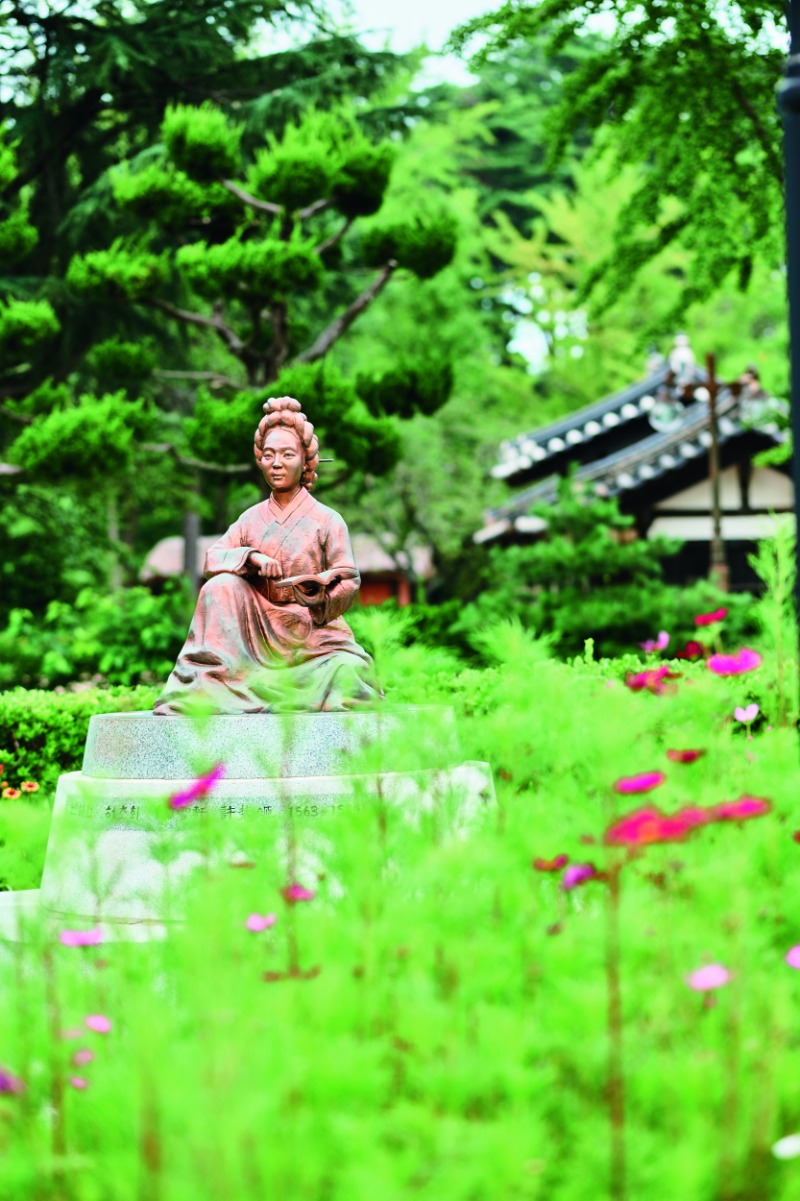
The mid-Joseon poet Heo Nanseolheon (1563-1589) was renowned for both her literary talent and beauty. Perhaps because of her unhappy family life, she mentions the desire to depart this world and become immortal in 128 of her 213 known works.
Gangneung was the birthplace of Heo Gyun (1569-1618), author of “The Tale of Hong Gil-dong” –considered the earliest Korean novel written in the Korean script, Hangeul – and his sister, the artist and poet Heo Nanseolheon (1563-1589). Heo Gyun was born into a noble family. Well-educated, he held various government posts, but as a progressive liberal who displayed books on Catholicism and advocated the removal of Confucianism in social and political activity, he became an outsider of Joseon. He dreamed of an ideal society called Yuldoguk, where everyone was equal, as depicted in his novel.
“I have an upright character and cannot stand by and watch when others do wrong, and I cannot bear the stupidity of vulgar scholars; it makes my stomach turn,” Heo Gyun said. He was repeatedly dismissed from and reinstated to government positions, and often exiled for his involvement in political feuds. Eventually, he was accused of treason and executed.
Perhaps most striking about Heo Gyun was his insight into his sister’s talent. Grieving over her early death at the age of 27, he combined her works into an anthology of poems. This was an extremely rare endeavor during the Joseon Dynasty, and Heo Nanseolheon’s poems first gained attention in China, not her homeland. The Heo Gyun and Heo Nanseolheon Memorial Park has a pine tree grove comparable to that around the three royal tombs of Gyeongju. The trees are numbered, and near No. 529 is a sign for a road named Gangneung Bau-gil. “Bau” is the local dialect term for “bawi,” or rock. Coincidentally, Bau is also the name of a Babylonian goddess who could heal a dying person with her bare hands, which is why some consider the road a healing road. Bau-gil is a magnificent road. It covers 280 km across 17 sections, connecting all parts of Gangneung, north, south, east and west — from Daegwallyeong to the coast, and from Okgye to Jumunjin. One of the bridges on the road has a statue of Hong Gildong, an outlaw who led a peasant army during the Joseon Dynasty, and a nearby monument inscribed with Heo Nanseolheon’s “Bamboobranch Poem”
By the streamside in Gangneung is our house.
In running water outside the gate I wash silken garments.
In the morning I tie up the boat
Wistfully watching the ducks fly away in pairs.
After reading the poem, I soon realized that the large modern building beside the field of reeds was the ARTE MUSEUM Gangneung. “There’s no hotter place right now for taking photos!” says one review. This museum, specializing in immersive media art exhibitions, especially beloved by millennials and the Generation Z crowd, is located next to the memorial park. The absence of a line at the entrance is deceptive. Inside, the museum is crammed with visitors. The hands of all the people taking pictures with their smartphones inside the dark gallery look like an art installation. The hundreds of photos on my phone tell me that the entrance fee was well worth paying.
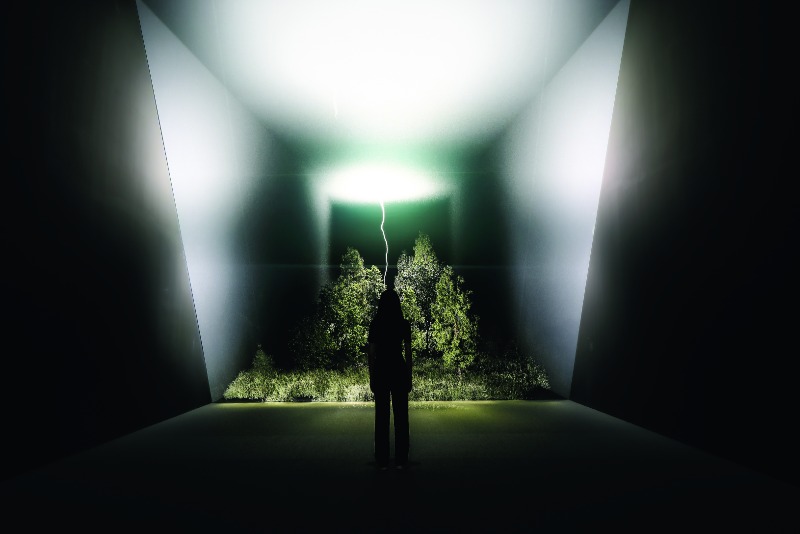
ARTE MUSEUM Gangneung is the third immersive art media space in the ARTE MUSEUM series to open, following those on Jeju lsland and in Yeosu. “THUNDER,” one of the first exhibitions presented at the museum, simulated being in the middle of a lightning strike.
ⓒ ARTE MUSEU
Coming to this state-of-the-art place after visiting Heo Gyun’s birthplace, the words “old and new” come to mind. The light and sounds of the videos seem to come right up in front of them, eliciting surprised looks. It looks like performance art. Walking through the media art presentations, I find myself behind a waterfall crashing down in front.
But emerging from the museum, I was astonished to realize that the vast body of water at the end of the bridge was not the sea. It was Gyeongpo Lake, which is actually a lagoon, a feature that is formed when the sea pushes the sand toan embankment that traps water.
The world is at its most beautiful when seen at a walking pace. It is only when you are walking slowly that you notice the scenery that you miss when driving or running. Seeing the butterflies and beetles flying around beautiful Gyeongpo Gasiyeon Wetlands, or the shade and the long shadows that waver according to the time of day – this is a gift you that you can’t enjoy during everyday life, but while taking slow steps on a leisurely respite.
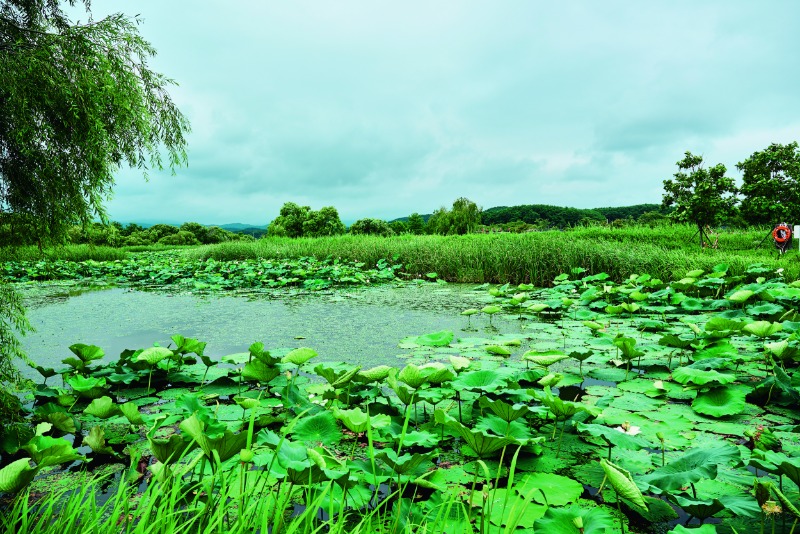
At Gyeongpo Prickly water lily Wetland, the once-endangered prickly water lily has been successfully revived and now forms dense growth. A trail has been made between the swamps, which attract water creatures such as otters and migratory birds.
BLACK BAMBOO
What would be one of the major symbols of a nation? Some that come to mind are Canada’s maple leaf, Brazil’s samba, or France’s Eiffel Tower. For the United States, the U.S. dollar, a global currency, is instantly recognizable. The 100-dollar bill is the largest denomination, and on the note is a picture of Benjamin Franklin, a founding father. So, who graces the 50,000 won note, Korea’s biggest denomination? None other than Shin Saimdang (1504-1551).
Five historical figures appear on Korean banknotes. Among them, one is the country’s most famous thinker and one-time prime minister, Yi I (1536-1584), known by his pen name Yulgok, and another is his mother, Shin Saimdang. It is the only case in the world where a mother and son separately grace a nation’s currency. Since Yi I was selected for the 5,000 won note in 1972, Ojukheon, the house where he was born, has appeared there with him. The word “ojuk” refers to a bamboo variety with black bark, and the black bamboo growing in the house’s yard earned Ojukheon its name.
In 1996, the residence was restored to its present state at the behest of the government. When it was incorporated with the Gangneung Municipal Museum in 1998, an exhibition featuring the history, culture, and historical sites of Gangneung was installed there, attracting 80,000 to 90,000 visitors annually. At the entrance leading to Ojukheon, people are standing about taking photos in front of the monument commemorating the mother-and-son banknotes. One couple takes out a 50,000 won note and a 5,000 won note, and holds them up as they pose for the camera. Walking around the birthplace of a famous person is like walking inside that person’s mind. After rain, the black of Ojukheon’s roof tiles and the green of the surrounding forest take on a deeper color, which seems to have a soothing effect on the visitors walking around, while the sound of the black bamboos swaying in the wind chases the heat away.
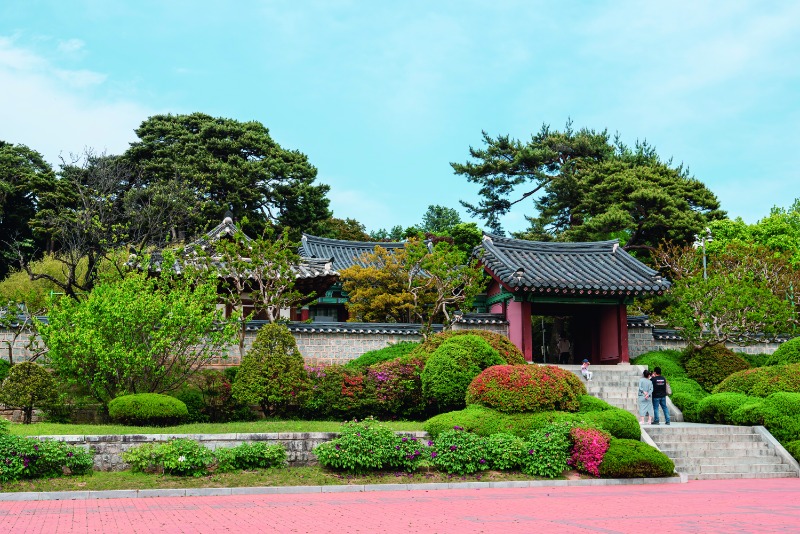
Ojukheon, the birthplace of Shin Saimdang and her son Yi I, is one of the oldest extant private homes in Korea. Portraits of mother and son grace the 50,000 won and 5,000 won banknotes, respectively.
ⓒ Shutterstock
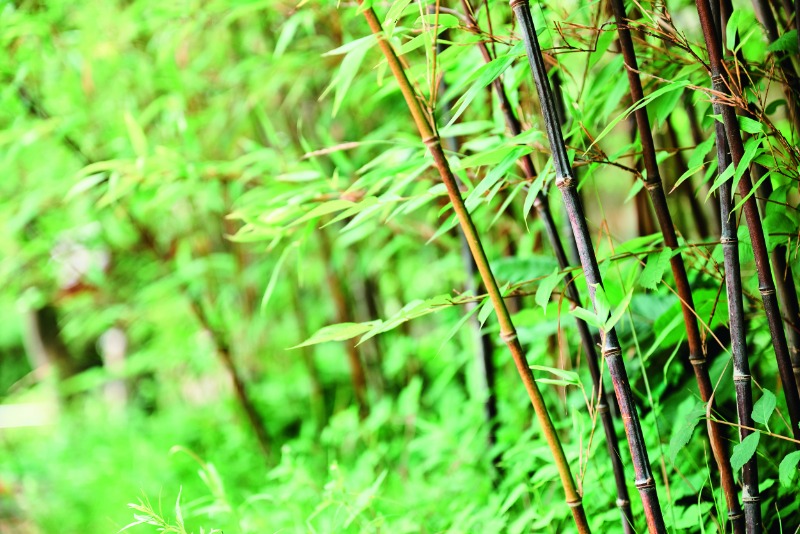
The name Ojukheon, is a compound of “o,” meaning “black,” and “juk,” meaning “bamboo.” It was inspired by the black bamboos surrounding the house.
CITY OF COFFEE
The origin of Gangneung’s coffee strip is a coffee vending machine that was installed in the fishing village of Anmok in the 1980s. Word spread among visitors to Anmok that the coffee from that particular machine was particularly good. Then more vending machines sprouted up along the road in front of the beach. The owners of the machines prepared the coffee powder mixes in their own special way and stuck detailed explanations on the front of the machine. Then, between the dozens of vending machines, cafés began to appear, eventually forming the famous coffee strip of Gangneung that even foreign tourists seek out today.
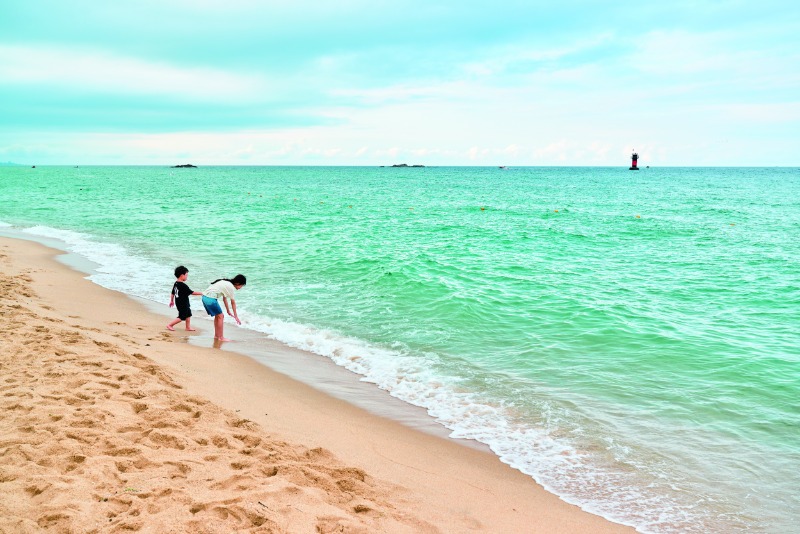
The Gyeongpodae area was designated as Gyeongpo Provincial Park in 1982. Gyeongpo Beach, known for its beautiful backdrop of pine trees, white sand and the blue waters of Gyeongpo Lake, is the largest beach on the east coast.
For Koreans born in the 1980s, Gangneung was known for Gyeongpodae and its beaches, but for young adults the city is known for its coffee. In a small city of just over 200,000 inhabitants, there are currently around five hundred cafes. One of the main reasons for the fame of Gangneung coffee is Park Ichu of the Bohemian Roasters café. Park Ichu’s name is permanently etched in Korea’s coffee history, because he was the first in Korea to roast fresh beans by himself. The level of roasting dictates coffee’s taste and aroma. As people learned how to savor coffee not only for its taste but also its aroma, Park Ichu’s coffee grew famous.
Park opened his first cafés in Seoul’s Hyehwa and Anam neighborhoods. Then, in 2021, he suddenly moved to Gyeongpodae in Gangneung. Relocating to the provinces rather than opening another branch in Seoul was a rather radical choice. The way in which an individual choice can have a butterfly effect and change the character of a whole city has always fascinated me. In the way that leafy Portland, Oregon, became an alternative for people tired of complicated city life in places like New York and Los Angeles, for Park Ichu Gangneung was the perfect city to embrace him.
Now, when people go to Gangneung, it is almost obligatory to stop by a coffee shop to buy some beans and take pictures in front of a big roasting machine. They also stop by Coffee Cupper, a museum where they can explore the history of coffee and look at the different varieties of coffee trees. It has become our daily routine to drink sweet mix-coffee to stay awake at night when working overtime, black coffee on the way to work in the morning, and a latte when feeling drowsy or hungry during the day. Koreans’ love of coffee has made it the country with the most cafés in the world compared to the number of cities. In Gangneung, that daily cup of coffee has d a new culture and a new city.
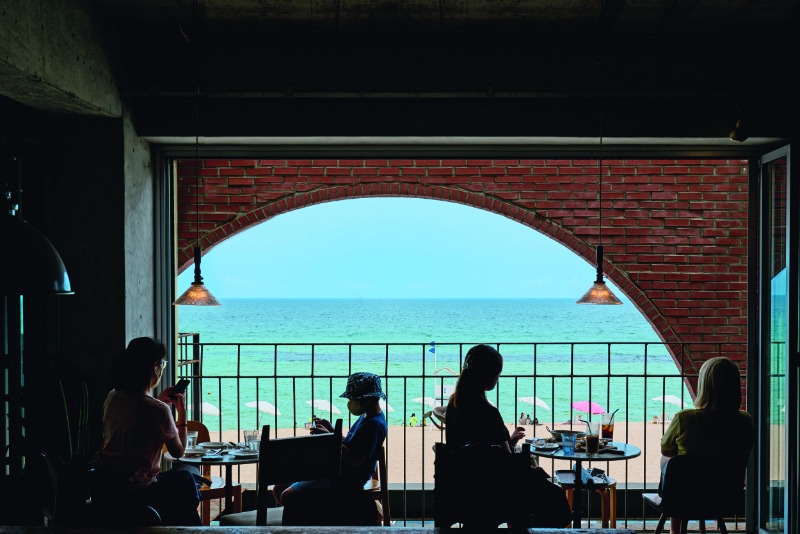
The café strip along Anmok Beach became a tourist attraction in the 1990s after old coffee vending machines from the 1980s were placed in front of the beach. Soon, a wave of coffee shops opened
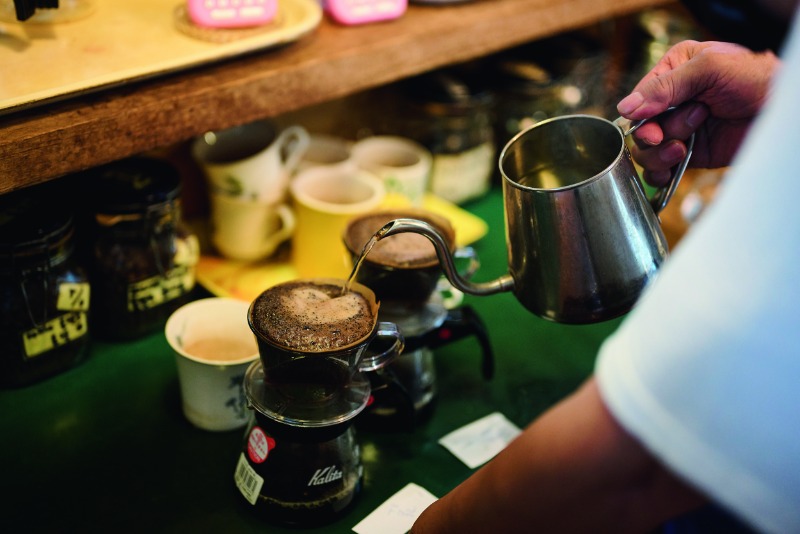
Park Ichu is the only one of the first-generation Korean baristas who is still active. A major force in bringing the café culture to Korea, Park moved from Seoul to Gangneung in 2000 and opened Bohemian Roasters, which has helped to turn Gangneung into a city of renowned for its coffee.
Baek Young-okNovelist
Han Jung-hyun 韓鼎鉉Photographer